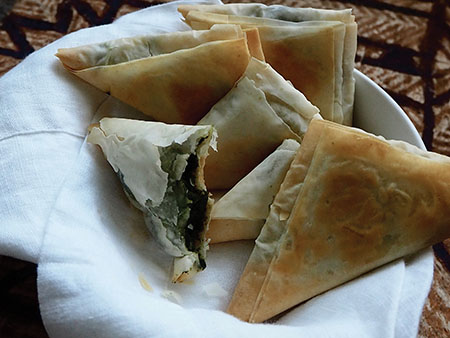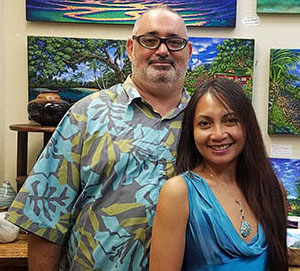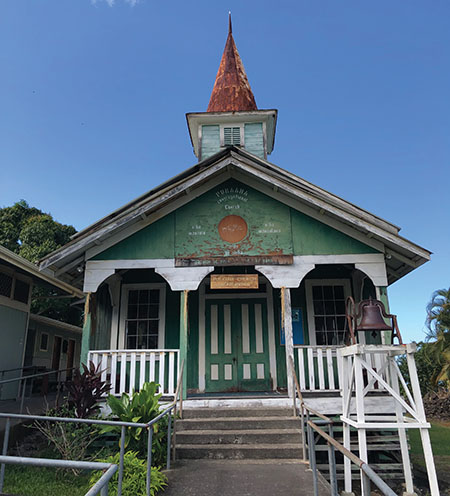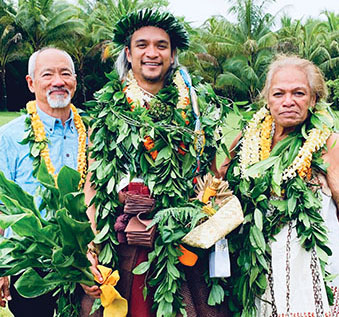
Kūha‘o Zane: “Hula is the vehicle for my identity to be passed on to me.”
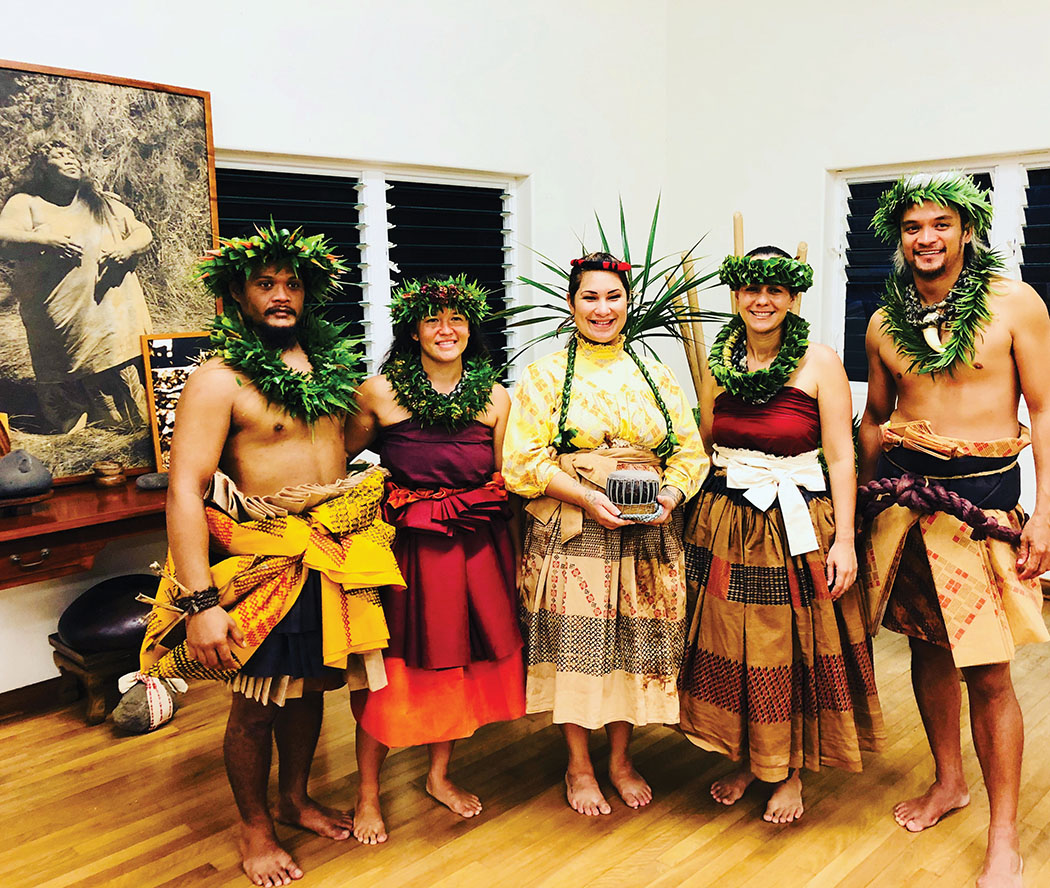
By Marcia Timboy
Kūha‘o Zane is a successful Hilo-based design professional. He’s also a cultural practitioner deeply rooted in ancestral traditions, with an esteemed hula lineage inherently connected to Hawai‘i Island. Kūha‘o has danced in 20 consecutive ho‘ike (exhibition) programs at the Merrie Monarch Festival.
Growing up in Hālau
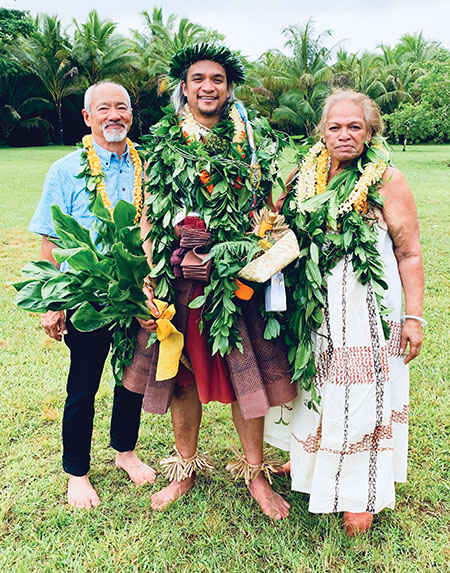
photo courtesy of Kūha‘o Zane
Kūha‘oimaikalani (Rain from Clear Sky) Zane was born in Hilo on December 29, 1983. His mother, Nalani Kanaka‘ole, is one of the two highly regarded kumu hula sisters of Hālau o Kekuhi, and his father, internationally-renowned clothing designer Sig Zane, danced with Hālau o Kekuhi in the 1970s.
Kūha‘o’s grandmother, Edith Kanaka‘ole (1913–1979), was one of the most revered figures of Hawaiian knowledge and hula, and was designated a “Living Treasure of Hawai‘i” in 1979. His maternal great-grandmother, Tūtū Fuji, chosen to be trained in a rural part of Pūna at a young age, learned the ancient form of hula called ‘ai ha‘a, and passed this knowledge to her ‘ohana. Thus, the lineage of hula followed the family’s bloodline.
Kūha‘o started learning hula when he was nine years old, relatively late as most haumana (students) begin at three or four years of age. He attributes his hesitancy in joining hālau to the social norms he held as a young boy, during a time when “masculinity…was a big thing.” He told his kumu hula mother, “I don’t want to dance because it’s for māhūs [in-the-middle, or third gender].” It wasn’t until his mom tricked him one day by saying he could hang out with his favorite cousins more if he practiced hula, that he acquiesced.
According to Kūha‘o, children in Hālau o Kekuhi are treated as “sacred cows.” His mother, Kumu Nalani, believes in latent learning: that children running around and playing while hālau is in session, will naturally absorb the oli (chants) and structural aesthetics of hula.
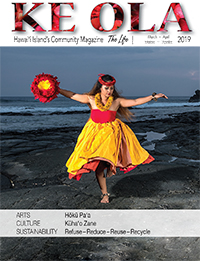
Traditional Hawaiian education is based on learning as much as you can without asking—don’t ask, wait to receive. His dad, Sig, practices Papio psychology—using a tool to lure, an action to attract what you want. Reciprocity. In this way one earns knowledge.
At the onset, Kūha‘o did not enjoy hula. He didn’t like the discipline it took to learn difficult movements. His aunt, Kumu Hula Pualani Kanaka‘ole Kanahele, once stated that Kūha‘o’s dancing for his first 10 years was “dutiful.” While he initially thought of this as a compliment, he eventually realized that it was her observance of mere compliance in his dancing.
Around the ninth grade, a shift occurred within Kūha‘o to adapt to learning versus fighting hula. Like most teenagers, he felt a need to develop more self-confidence; traveling abroad and performing on stage helped him achieve this. Seeing his cousins travel to other places with hālau to perform Kamehameha Pai‘ea, a “masculine expression of hula,” had a great impact on him as well.
Personal and Cultural Identity
The first time Kūha‘o took hula seriously and with more commitment was when he was in the 11th grade and touring Japan, recently reflecting, “I experienced a different culture, which shaped an appreciation of my own culture.”
At this time, he likened hula to body boarding, learning how to maneuver moves to reach a goal. For Kūha‘o, hula became learning by interaction, and as a constant learner he felt the need to always improve. “You make a mistake, and fix it. It’s how quickly can you learn.” Another push for learning quickly was that “girls outnumber boys in hula, therefore boys move faster up the ranks, because boys are needed in performances.”
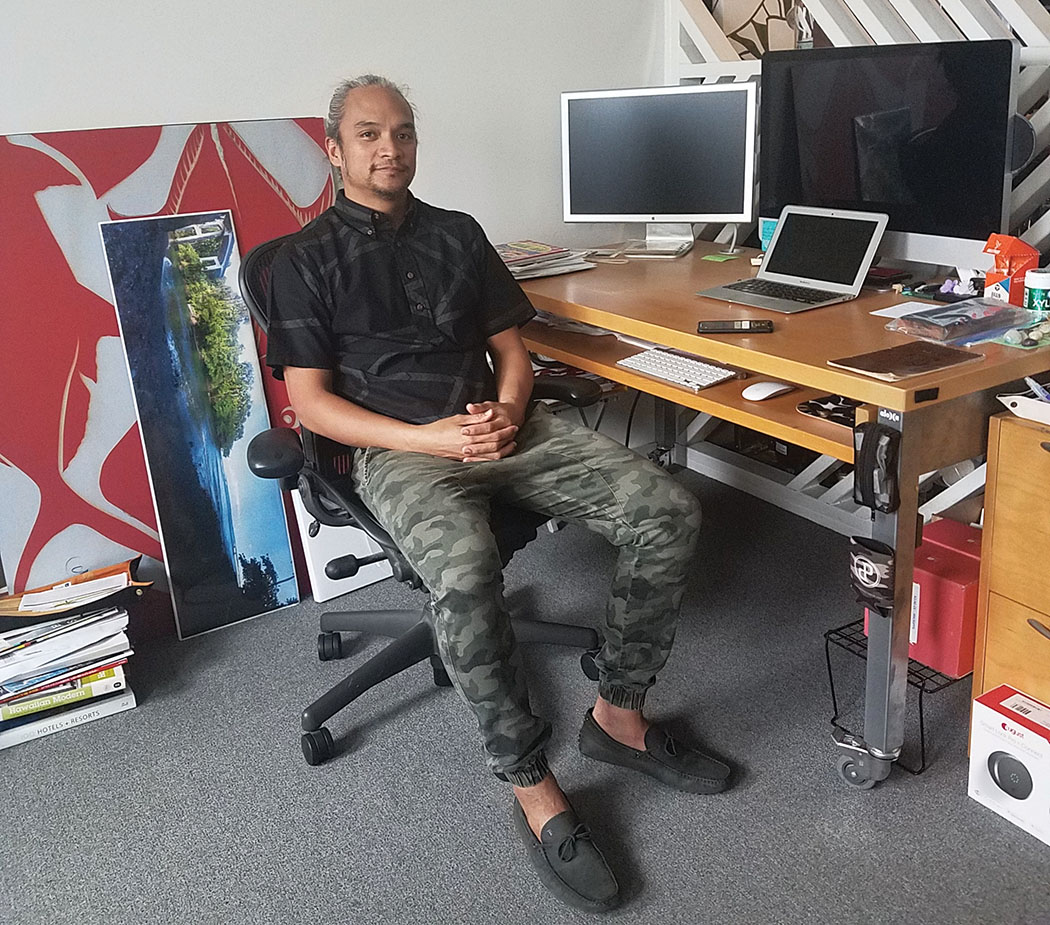
In 2002, Kūha‘o returned from college, graduating with a degree from the Institute of Fashion Design and Merchandising in Los Angeles. He began to enjoy and appreciate dancing, and regarded hula as an art form like ballet. He also realized that the hula aesthetic of his mother’s crisp and linear choreography—with strong, straight lines conveying energy out—influenced his own sense of graphic design.
In 2003, Hālau o Kekuhi was invited to represent Hawaiian culture at the Cultural Olympiad, a prelude to the 2004 Olympic Games. This event was a major turning point for Kūha‘o. The experience expanded his world view, as members of the hālau visited ancient Olympic “power sites” and participated in cultural exchange with other nations.
Whenever the hālau performed, they were asked where they were from. Kūha‘o felt a stronger sense of identity when defining himself and Hawaiian culture. He realized that “the energy that hula exudes speaks a global language, and is a way of connecting that is universal, as in other archaic cultural art, which has evolved over the years.”
The Elevation. “The ‘Uniki.”
In May 2016, Nalani Kanaka‘ole Zane had a serious health episode at a hula event. “Does our schooling end now?” her haumana queried as their kumu’s (source) finiteness was realized.
In December 2016, Kumu Nalani announced to the hālau, “I’m going to put you through classes, regular meetings, and have a ceremony.” Kūha‘o’s personal opinion was that “Mom felt the urgency to acknowledge us, the haumana, and our studies, commitment, and time.”
Her curriculum covered cultural origins and theory of hula, when the reenactment of the natural world and the deities took form in hula, hula terminology, the transference of mana, the origins of Hālau o Kekuhi, the exploration and full comprehension of kaona (hidden meaning), comprehensive knowledge of and skills required for each of the hula implements, and making one’s own hula implements.
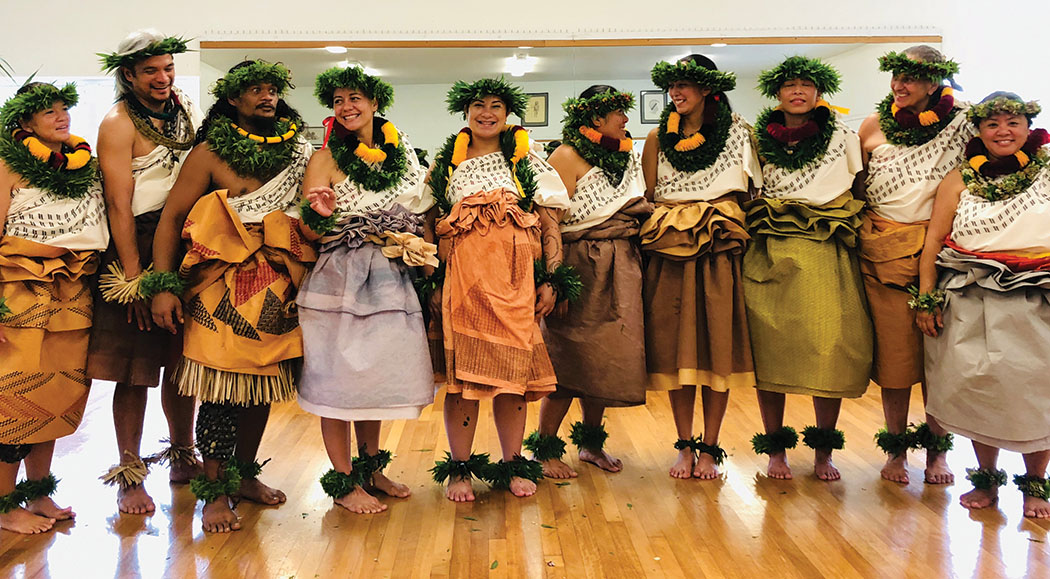
During a two-year period, research projects were assigned leading up to two ceremonies: the practicum on August 26, 2018, and the ‘uniki or elevation on November 12, 2018.
The intensive procedure and ceremonies that Kūha‘o completed had all the components and protocol of ‘uniki, yet was considered an “elevation,” a transcendence or rising up to the next level.
In hula tradition, ‘uniki is more than a graduation; it is the separation from the original hālau once the ‘olapa (advanced hula dancer) has achieved mastery of a large body of traditional hula numbers that are a part of their hālau traditions, and has assimilated knowledge of cultural origins and theory of hula, hula terminology, and hula implements and fabrication.
The ‘uniki separates the ‘olapa from the original hālau, and then the ‘olapa is given a kuahu (hula altar) to start their own hālau. Once ‘uniki, the ‘olapa will not perform with their former hālau; this is the traditional way. The most recent Merrie Monarch competition rules state that dancers who ‘uniki cannot perform with their previous hālau.
Although Kūha‘o and others in his group, Papa Pa I‘ei‘e— named after the highest-ranking plant of all the kinolau (hula plants) on the hula kuahu—completed the intensive two-year training process, they did not technically ‘uniki, so they can continue to perform with Hālau o Kekuhi.
When asked when one is ready to ‘uniki, Kuha‘o adamantly replied, “You don’t go into hālau to get ‘uniki to become a kumu. You can’t just say you want to become a kumu hula.” One has to earn it.
“You don’t just learn the moves when you learn hula,” adds Kūha‘o, “you learn the history. You learn the background. You learn what flowers to pick when you’re making certain lei. You learn about the mele—some of these mele date back 300 years.”
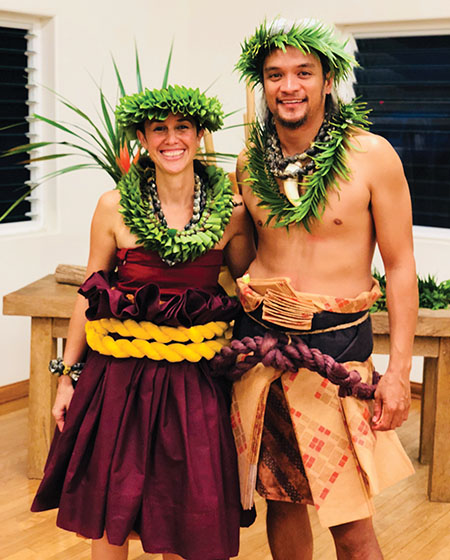
With 20-plus years of building a foundation, Kūha‘o took a month off work to prepare for the practicum. He felt he lacked experience as ho‘opa‘a (one who has learned oli and mele and is capable to lead, call, and impart knowledge to other dancers).
He had never taught any of the younger haumana and found it difficult to ho‘opa‘a to a dancer. Once again, he felt he was trying to catch up. The practicum was very challenging for Kūha‘o, and the time between the two ceremonies was spent reassessing himself.
Kūha‘o was pleased with the ‘a‘ahu (performance costume) that he had to make with all-natural materials. He used amau (fern) and māmaki plant dyes, and the ash from Mt. Aso, Japan as an activator to set the dyes. He was also required to make his own lei and kupe‘e (adornments) to complete the ensemble.
He was most appreciative in learning the core elements of oli, including the thought processes and layering of the kaona, and how the final product would be perceived. These elements needed to be fully understood in order to haku (create, compose, weave together) an oli. Kūha‘o feels his biggest achievement of the whole ‘uniki process was to haku oli (write his own chant), and to translate, then perform it. “I never imagined myself as a conductor.”
“The coolest thing [of the elevation ‘uniki process] was watching everyone else go through their own challenges and achievements.”
Ho‘omau…
“To continue, keep on, persist, renew, perpetuate, and persevere, last, to mate in order to conceive.”
Kūha‘o believes the greatest contribution of the elevation (‘uniki) process is EA (life, sovereignty) giving the majority of youth a transference of knowledge.
The ho‘okupu (offerings of respect) given to his mother as a result of the ‘uniki is “the progression and perpetuation of hula and mele on all levels.”
The knowledge and legacy of a hula lineage endures. ❖
For more information: edithkanakaolefoundation.org/halauOKekuhi.php
Mahalo Kings’ Shops—Culture Story Sponsor
